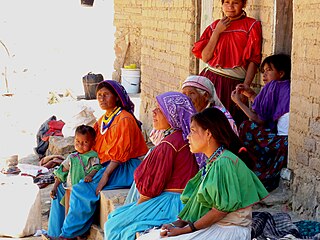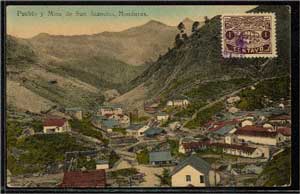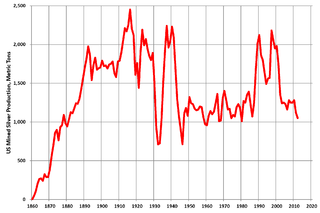
San Luis Potosí, officially the Free and Sovereign State of San Luis Potosí, is one of the 32 states which compose the Federal Entities of Mexico. It is divided in 58 municipalities and its capital city is San Luis Potosí City.

Eldorado Gold Corporation is a Canadian company that owns and operates gold mines in Turkey, Greece and Canada. Since its merger with European Goldfields in 2011 the company has been pursuing the development of the Skouries mine, Olympias mine and Stratoni mine in Greece. The company previously developed and operated gold mines in China, Brazil and Mexico. Headquartered in Vancouver and listed on the Toronto and New York Stock Exchanges, Eldorado Gold has developed and operated assets from several merged companies HRC Developments Corporation, Afcan Mining Corporation, Sino Gold Mining, Brazauro Resources, Integra Gold, as well as European Goldfields.

The Huichol or Wixárika are an Indigenous people of Mexico living in the Sierra Madre Occidental range in the states of Nayarit, Jalisco, Zacatecas, and Durango, with considerable communities in the United States, in the states of California, Arizona, New Mexico, and Texas. They are best known to the larger world as the Huichol, although they refer to themselves as Wixáritari in their Huichol language. The adjectival form of Wixáritari and name for their own language is Wixárika.
Goldcorp Inc. was a gold production company headquartered in Vancouver, British Columbia, Canada. The company stood among the largest gold producers in the world, employed about 15,800 people worldwide, engaged in gold mining and related activities including exploration, extraction, processing and reclamation. Goldcorp’s operating assets included eleven mines in North and South America.

Wirikuta is a desert, sacred to the Wixárika (Huichol) people high in the mountains of central Mexico, between the Sierra Madre Oriental and the Zacatecas ranges, near Real de Catorce. In Wixárika cosmology, the world is believed to have been created in Wirikuta.
Yamana Gold Inc. is a Canadian company that owns and operates gold, silver and copper mines in Canada, Chile, Brazil and Argentina. Headquartered in Toronto, the company was founded in 1994 and became listed on the Toronto Stock Exchange in 1995, the New York Stock Exchange in 2007, and the London Stock Exchange in 2020. The company became a gold producer after its 2003 re-restructuring in which Peter Marrone took over as chief executive officer and it merged with Brazilian company Santa Elina Mines Corporation. The combined company was able to use Yamana's access to capital with Santa Elina development properties to bring the Chapada mine into production. From there the company combined with other TSX-listed companies RNC Gold, Desert Sun Mining, Viceroy Exploration, Northern Orion Resources, Meridian Gold, Osisko Mining and Extorre Gold Mines which each contributed either a producing mine or a development project that was able to come into commercial production. The company was acquired by Pan American Silver in March 2023.
Kinross Gold Corporation is a Canadian-based gold and silver mining company founded in 1993 and headquartered in Toronto, Ontario, Canada. Kinross currently operates six active gold mines, and was ranked fifth of the "10 Top Gold-mining Companies" of 2019 by InvestingNews. The company's mines are located in Brazil, Mauritania, and the United States. It trades under the KGC ticker in the New York Stock Exchange, and under K in the Toronto Stock Exchange.

The New York and Honduras Rosario Mining Company (NYHRMC), known as Rosario Mining Company, was an American-owned corporation that owned and operated the Rosario mine, a gold and silver producer in central Honduras and Nicaragua.

Silver mining in the United States began on a major scale with the discovery of the Comstock Lode in Nevada in 1858. The industry suffered greatly from the demonetization of silver in 1873 by the Coinage Act of 1873, known pejoratively as the "Crime of 73", but silver mining continues today.

Shafter is a ghost town in Presidio County, Texas, United States. The Texas Attorney General's Office listed a population of 11 as of the 2000 Census. It was named in honor of General William R. Shafter, who at one point commanded the nearby Fort Davis. As of 2012, at least one silver mine, La Mina Grande, had been reopened by Aurcana Corporation.
Coeur Mining, Inc. is a precious metals mining company listed on the New York Stock exchange. It operates five mines located in North America. Coeur employs 2,200 people and in 2012 it was the world's 9th largest silver producer. In 2013 the company changed its name to Coeur Mining, Inc. from Coeur d'Alene Mines and moved its head office to Chicago, Illinois from Coeur d'Alene, Idaho.
Iamgold Corporation is a Canadian company that owns and operates gold mines in Burkina Faso and Canada. Headquartered in Toronto, the company was incorporated in 1990, and went public on the Toronto Stock Exchange in 1996, with additional shares being listed on the New York Stock Exchange beginning in 2005. The company formerly owned or had stakes in the Sadiola and Yatela gold mines in Mali, the Mupane gold mine in Botswana, the Niobec niobium mine in Quebec, as well as a royalty in the Diavik Diamond Mine.

The Abitibi gold belt is a region of Canada that extends from Wawa, Ontario to Val-d'Or, Quebec. Located within the mineral-rich Abitibi greenstone belt, the gold belt is an established gold mining district having produced over 100 mines, and 170 million ounces of gold since 1901. Timmins, a town founded in 1912 following the Porcupine Gold Rush and subsequent creation of the Hollinger Mines, McIntyre Mines and Dome Mine, which was one area in the region that experienced a gold rush, beginning in 1909. The Kerr Addison Mine in Virginiatown was at one time Canada's largest gold producing mine. Many of the towns readily acknowledge gold mining as part of their history, some being named after gold. One of Canada's 'large roadside attractions' is a 12-foot replica of a 1908 gold sovereign built to commemorate Canada's first gold coin which was made using gold from the Kerr Addison owned Kerr-Addison mine.
Wheaton Precious Metals Corp. is a Canadian multinational precious metals streaming company. It produces over 26 million ounces and sells over 29 million ounces of silver mined by other companies as a by-product of their main operations.
New Gold Inc. is a Canadian mining company that owns and operates the New Afton gold-silver-copper mine in British Columbia and the Rainy River gold-silver mine in Ontario, Canada. Through a Mexican subsidiary company, they also own the Cerro San Pedro gold-silver mine in San Luis Potosí, Mexico, which ceased operation in 2017. While New Gold was founded in 1980 for the purposes of mineral exploration, the company became a mine operator with its merger of Peak Gold and Metallica Resources in 2008. A fourth company, Western Goldfields, joined in 2009. Together they operated the Peak mine in Australia and Mesquite Mine in California but sold both in 2018. Headquartered in Toronto, shares of the company are traded on the Toronto Stock Exchange and NYSE American.

Thompson Creek Metals Company Inc. was a full cycle mining company with acquisition, exploration, development, and operation in North America. The corporate office was located in Denver, Colorado. The company primarily produced copper, gold, and molybdenum. Over its history, the Company evolved from being a major primary molybdenum producer to becoming a copper and gold mining company with the construction and development of the Mount Milligan mine and concentrator in British Columbia, Canada. Mount Milligan was Thompson Creek Metals principal operation and the company owned 100% of this property. The company also owned 100% of its Thompson Creek Mine in Idaho. Thompson Creek Metals owned 75% joint venture interest in two other properties, including its Endako Mine in British Columbia, and its Langeloth Metallurgical Facility (roaster) in Pennsylvania. Thompson Creek Metals had additional development projects, including the Berg property in British Columbia.

The El Indio Gold Belt is a mineral-rich region spanning the border between Chile and Argentina that contains large quantities of gold, silver and copper. On both sides of the border the belt is located within the Andes. The El Indio mine within the district was the first modern mine in Chile to produce gold as its main product. In Chile the main precious metal containing mineral is enargite. The El Indio belt is bordered in the north by another gold-silver mining district known as the Frontera District. Rodalquilarite, alunite and poughite are some of the minerals present in the area. The deposits of the belt formed during the Late Miocene period.
AuRico Gold was an intermediate gold mining and exploration company that, until August 2011, operated only in Mexico. It reached intermediate gold producer status in August 2011 when Northgate Minerals agreed to be taken over for C$1.46 billion. Gammon Gold was an exploration company until 2004 when it started producing for the first time. Assets also include silver and copper.
Fortuna Silver Mines Inc. ("Fortuna") is a Canada-based precious metals mining company with operations in Argentina, Burkina Faso, Côte d'Ivoire, Mexico, Peru, and Senegal. The Company is primarily engaged in producing gold and silver with by-products lead and zinc. Fortuna’s operating mines are the Séguéla Mine, Yaramoko Mine, Lindero Mine, San Jose Mine, and Caylloma Mine. In 2023, Fortuna produced 326,638 ounces of gold, 5.9 million ounces of silver, or 452,389 gold equivalent ounces.

Alamos Gold Inc. ("Alamos") is a Canadian multinational gold producer, headquartered in Toronto, Canada. Alamos operates three mines across North America, and has six further projects in development.











